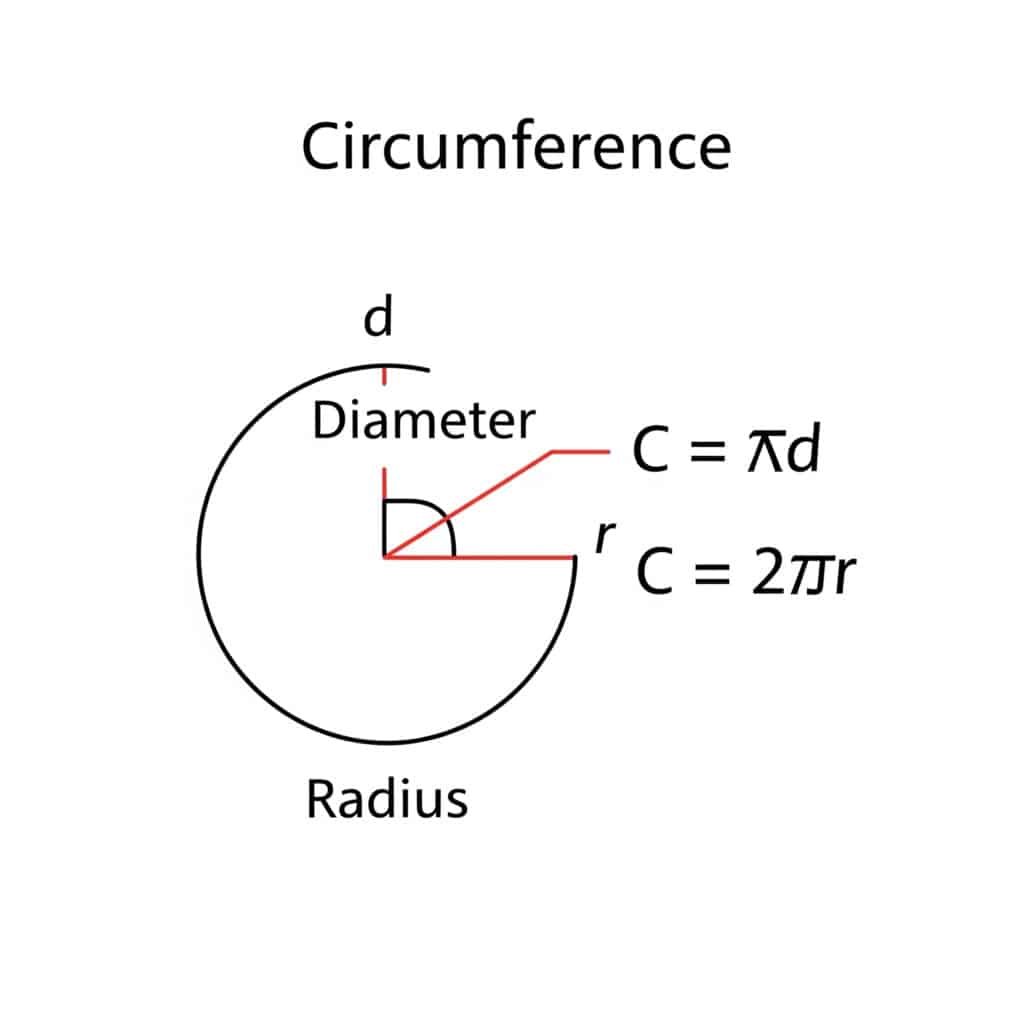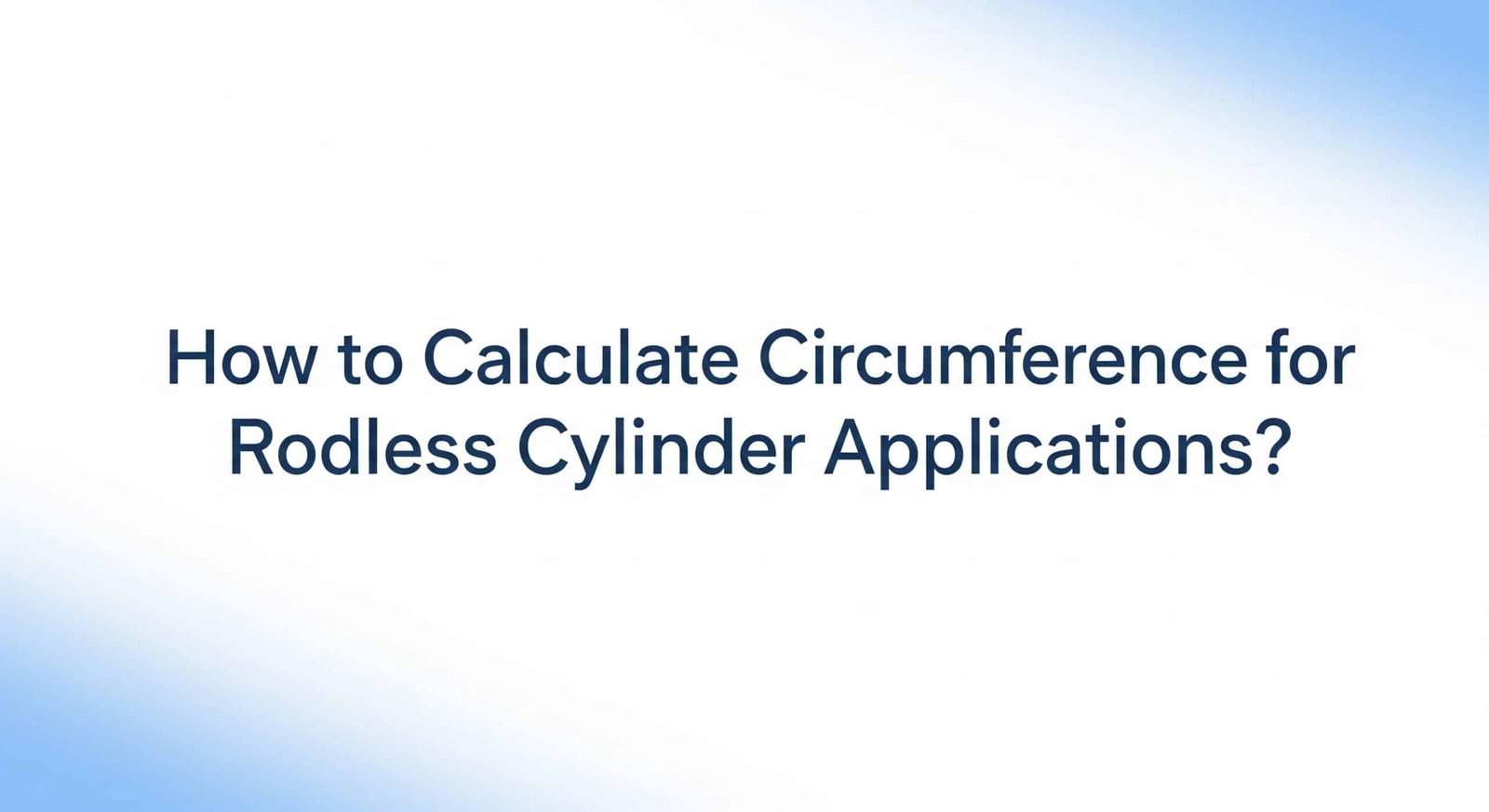
Engineers frequently struggle with circumference calculations when sizing rodless pneumatic cylinders. Incorrect measurements lead to seal failures and costly equipment downtime.
Circumference equals π times diameter (C = πd) or 2π times radius (C = 2πr), providing the distance around any circular cross-section of your rodless cylinder.
Last week, I received an urgent call from Henrik, a maintenance supervisor in Sweden, whose team miscalculated circumference for guided rodless cylinder seals, causing a $15,000 production halt.
Table of Contents
- What is the Basic Circumference Formula for Rodless Cylinders?
- How Do You Measure Diameter for Rodless Air Cylinder Circumference?
- What Tools Help Calculate Circumference in Pneumatic Applications?
- How Does Circumference Affect Rodless Cylinder Performance?
What is the Basic Circumference Formula for Rodless Cylinders?
Circumference calculations form the foundation for all rodless pneumatic cylinder sizing, seal selection, and surface area determinations in industrial applications.
Use C = πd when you know the diameter, or C = 2πr when you know the radius. Both formulas give identical results for rodless cylinder circumference calculations.

Two Standard Circumference Formulas
Formula Using Diameter
C = πd
- C: Circumference
- π: 3.14159 (mathematical constant)
- d: Diameter of rodless cylinder
Formula Using Radius
C = 2πr
- C: Circumference
- 2π: 6.28318 (2 × π)
- r: Radius of rodless cylinder
Circumference Calculation Examples
| Cylinder Size | Diameter | Radius | Circumference |
|---|---|---|---|
| Small | 32mm | 16mm | 100.5mm |
| Medium | 63mm | 31.5mm | 198.0mm |
| Large | 100mm | 50mm | 314.2mm |
| Extra Large | 125mm | 62.5mm | 392.7mm |
Step-by-Step Calculation Process
Method 1: Using Diameter
- Measure cylinder diameter: Use calipers for accuracy
- Multiply by π: d × 3.14159
- Round to practical precision: Usually 0.1mm for rodless cylinders
Method 2: Using Radius
- Measure cylinder radius: Half the diameter
- Multiply by 2π: r × 6.28318
- Verify against diameter method: Results should match
Common Rodless Cylinder Sizes
Standard Bore Sizes
- 20mm bore: C = 62.8mm
- 32mm bore: C = 100.5mm
- 40mm bore: C = 125.7mm
- 50mm bore: C = 157.1mm
- 63mm bore: C = 198.0mm
- 80mm bore: C = 251.3mm
- 100mm bore: C = 314.2mm
Practical Applications
I use circumference calculations for:
- Seal sizing: O-ring and gasket specifications
- Surface area calculations: Coating and treatment requirements
- Magnetic coupling design: For magnetic rodless cylinders
- Wear analysis: Contact surface evaluation
How Do You Measure Diameter for Rodless Air Cylinder Circumference?
Accurate diameter measurement ensures precise circumference calculations, preventing costly seal failures and performance issues in rodless pneumatic systems.
Use digital calipers to measure the outer diameter at multiple points along the cylinder length, then calculate the average for most accurate circumference results.
Essential Measurement Tools
Digital Calipers
- Accuracy: ±0.02mm precision
- Range: 0-150mm for most rodless cylinders
- Features: Digital display, metric/imperial conversion
- Cost: $25-50 for quality instruments
I recommend using digital calipers1 for their precision and ease of use.
Measuring Tape Method
- Flexible tape: Wrap around cylinder circumference
- Direct reading: No calculation required
- Accuracy: ±0.5mm typical
- Best for: Large diameter cylinders over 100mm
Measurement Techniques
Multi-Point Measurement
- Measure at three locations: Both ends and center
- Record all readings: Check for variations
- Calculate average: Sum ÷ 3 for final diameter
- Check tolerance: ±0.1mm acceptable variation
Cross-Measurement Verification
- Perpendicular measurements: 90° apart
- Maximum vs minimum: Should be within 0.05mm
- Out-of-round detection: Critical for seal performance
Common Measurement Errors
| Error Type | Cause | Impact | Prevention |
|---|---|---|---|
| Parallax reading | Viewing angle | ±0.1mm error | Read at eye level |
| Caliper pressure | Too much force | Compression error | Light, consistent pressure |
| Surface contamination | Dirt/oil buildup | False readings | Clean before measuring |
| Temperature variation | Thermal expansion2 | Size changes | Measure at room temperature |
Measuring Different Cylinder Types
Double Acting Rodless Cylinders
- Measure bore diameter: Internal cylinder dimension
- Account for wall thickness: If measuring externally
- Multiple measurement points: Along stroke length
Magnetic Rodless Cylinders
- External housing: Overall diameter measurement
- Internal bore: Separate measurement required
- Magnetic coupling clearance: Factor in design tolerances
Guided Rodless Cylinders
- Guide rail clearance: Affects overall dimensions
- Mounting considerations: Access for measurement
- Linear bearing surfaces: Critical dimension points
Diameter Conversion Reference
Metric to Imperial
- 25.4mm = 1 inch
- Common sizes: 32mm = 1.26″, 63mm = 2.48″
- Precision: Calculate to 0.001″ for accuracy
Fractional Equivalents
- 20mm: 25/32″
- 25mm: 1″
- 32mm: 1-1/4″
- 40mm: 1-9/16″
- 50mm: 2″
What Tools Help Calculate Circumference in Pneumatic Applications?
Modern calculation tools streamline circumference determination for rodless cylinder projects, reducing errors and improving efficiency in pneumatic system design.
Digital calculators, smartphone apps, and online circumference calculators provide instant, accurate results for any rodless pneumatic cylinder diameter measurement.
Digital Calculation Tools
Scientific Calculators
- Built-in π function: Eliminates manual entry errors
- Memory functions: Store multiple calculations
- Precision: 8-12 decimal places
- Cost: $15-30 for engineering models
Smartphone Applications
- Engineering calculators: Free downloads available
- Unit conversion: Automatic metric/imperial switching
- Formula storage: Save frequently used calculations
- Offline capability: Works without internet connection
Online Calculation Resources
Web-Based Calculators
- Instant results: Enter diameter, get circumference
- Multiple units: mm, inches, feet supported
- Formula display: Shows calculation method
- Free access: No software installation required
Engineering Websites
- Comprehensive tools: Multiple geometric calculations
- Technical references: Formula explanations included
- Professional accuracy: Verified calculation methods
- Industry standards: Aligned with pneumatic specifications
Calculation Shortcuts
Quick Estimation Methods
- Diameter × 3: Rough approximation (5% error)
- Diameter × 3.14: Standard accuracy
- Diameter × 3.14159: High precision
Memory Aids
- π ≈ 22/7: Fractional approximation
- π ≈ 3.14: Common rounded value
- 2π ≈ 6.28: For radius calculations
Calculation Verification
Cross-Check Methods
- Calculator vs manual: Compare results
- Different formulas: πd vs 2πr
- Unit conversion: Verify metric/imperial
- Practical measurement: Tape measure confirmation
Error Detection
- Unrealistic results: Check input values
- Unit mistakes: Verify mm vs inches
- Decimal errors: Confirm decimal placement
- Formula selection: Ensure correct method
Professional Calculation Software
CAD Integration
- Automatic calculation: Built into design software
- Parametric updates: Changes update automatically
- Drawing annotation: Results appear on drawings
- Standards compliance: Industry specification alignment
Professional software with CAD Integration3 automatically calculates dimensions and updates them when design parameters change.
Specialized Pneumatic Software
- Cylinder sizing: Complete system calculations
- Performance prediction: Flow and force analysis
- Component selection: Integrated parts databases
- Cost estimation: Material and labor calculations
When I help customers like James, a project engineer from Texas, I recommend using multiple calculation methods to verify circumference results. This redundancy prevents the measurement errors that caused his original magnetic rodless cylinder installation delays.
How Does Circumference Affect Rodless Cylinder Performance?
Circumference directly impacts seal effectiveness, surface area calculations, and overall performance characteristics of rodless pneumatic cylinder systems.
Larger circumference increases surface area for better heat dissipation and load distribution, but requires more sealing force and higher pressure ratings for optimal performance.
Performance Impact Areas
Sealing Effectiveness
- Contact area: Larger circumference = more seal contact
- Pressure distribution: Circumference affects seal loading
- Leak prevention: Proper sizing critical for air-tight operation
- Wear patterns: Circumference influences seal life
Heat Dissipation
- Surface area: Greater circumference improves cooling
- Thermal capacity: Larger cylinders handle heat better
- Operating temperature: Affects maximum duty cycles
- Material selection: Temperature ratings vary by size
Circumference and Force Output
Pressure-Force Relationship
Force = Pressure × Area4
Area = π × (diameter/2)²
| Diameter | Circumference | Area | Force at 6 bar |
|---|---|---|---|
| 32mm | 100.5mm | 804mm² | 483N |
| 63mm | 198.0mm | 3,117mm² | 1,870N |
| 100mm | 314.2mm | 7,854mm² | 4,712N |
Load Distribution
- Larger circumference: Spreads loads over more area
- Reduced stress: Lower pressure per unit area
- Extended life: Less wear on individual components
- Improved reliability: Better fatigue resistance
Circumference in Different Applications
High-Speed Operations
- Smaller circumference: Reduced inertia
- Faster acceleration: Lower mass to move
- Higher frequencies: Better dynamic response
- Precision control: Improved positioning accuracy
Heavy-Duty Applications
- Larger circumference: Greater force capacity
- Load handling: Higher weight ratings
- Durability: Extended service life
- Stability: Better load distribution
Maintenance Considerations
Seal Replacement
- Circumference matching: Critical for proper fit
- Groove dimensions: Must match original specifications
- Material compatibility: Size affects material choice
- Installation tools: Larger sizes need special equipment
Surface Treatment Requirements
- Coating area: Circumference × length
- Material costs: Proportional to surface area
- Treatment time: Larger surfaces take longer
- Quality control: More area to inspect
Cost-Performance Optimization
Size Selection Criteria
- Required force: Minimum diameter needed
- Space constraints: Maximum diameter allowed
- Cost considerations: Larger = more expensive
- Performance requirements: Speed vs force trade-offs
Economic Analysis
- Initial cost: Increases with circumference
- Operating costs: Efficiency varies by size
- Maintenance frequency: Size affects service intervals
- Total cost of ownership5: Long-term economic impact
Conclusion
Calculate circumference using C = πd or C = 2πr formulas. Accurate measurements ensure proper rodless cylinder sizing, seal selection, and optimal pneumatic system performance.
FAQs About Circumference Calculations
What is the easiest way to calculate circumference?
Use the formula C = πd (circumference = π × diameter). Simply multiply your rodless cylinder diameter by 3.14159 for accurate results. Digital calculators with π functions eliminate manual calculation errors.
How do you measure diameter for circumference calculations?
Use digital calipers to measure rodless cylinder diameter at multiple points along the length. Take measurements at both ends and center, then calculate the average for most accurate circumference results.
What tools help calculate circumference quickly?
Digital calculators with π functions, smartphone engineering apps, and online circumference calculators provide instant accurate results. These tools eliminate manual calculation errors common in pneumatic applications.
Why is accurate circumference important for rodless cylinders?
Accurate circumference ensures proper seal sizing, surface area calculations, and force output predictions. Incorrect measurements lead to seal failures, performance issues, and costly equipment downtime in rodless pneumatic systems.
How does circumference affect rodless cylinder performance?
Larger circumference increases force output and heat dissipation but requires higher sealing forces. Smaller circumference provides faster response and lower costs but limits maximum force capacity in rodless air cylinder applications.
-
Learn how digital calipers work and the proper techniques for taking precise measurements in engineering applications. ↩
-
Explore the scientific principle of thermal expansion and how temperature affects the dimensions of different materials. ↩
-
Discover how Computer-Aided Design (CAD) integration streamlines workflows by connecting design data with other software tools. ↩
-
Understand the fundamental relationship between force, pressure, and area with this foundational physics formula. ↩
-
Gain insights into the Total Cost of Ownership (TCO) framework for evaluating the full lifetime cost of an asset beyond its purchase price. ↩



